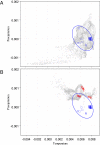Niches and distributional areas: concepts, methods, and assumptions
- PMID: 19805041
- PMCID: PMC2780935
- DOI: 10.1073/pnas.0901637106
Niches and distributional areas: concepts, methods, and assumptions
Abstract
Estimating actual and potential areas of distribution of species via ecological niche modeling has become a very active field of research, yet important conceptual issues in this field remain confused. We argue that conceptual clarity is enhanced by adopting restricted definitions of "niche" that enable operational definitions of basic concepts like fundamental, potential, and realized niches and potential and actual distributional areas. We apply these definitions to the question of niche conservatism, addressing what it is that is conserved and showing with a quantitative example how niche change can be measured. In this example, we display the extremely irregular structure of niche space, arguing that it is an important factor in understanding niche evolution. Many cases of apparently successful models of distributions ignore biotic factors: we suggest explanations to account for this paradox. Finally, relating the probability of observing a species to ecological factors, we address the issue of what objects are actually calculated by different niche modeling algorithms and stress the fact that methods that use only presence data calculate very different quantities than methods that use absence data. We conclude that the results of niche modeling exercises can be interpreted much better if the ecological and mathematical assumptions of the modeling process are made explicit.
Conflict of interest statement
The authors declare no conflict of interest.
Figures



References
-
- Grinnell J. Barriers to distribution as regards birds and mammals. Am Nat. 1914;48:248–254.
-
- Grinnell J. The niche-relationships of the California Thrasher. Auk. 1917;34:427–433.
-
- Grinnell J. Field tests of theories concerning distributional control. Am Nat. 1917;51:115–128.
-
- Hutchinson GE. Concluding remarks. Cold Spring Harbor Symp Quant Biol. 1957;22:415–427.
-
- Hutchinson GE. An Introduction to Population Ecology. New Haven, CT: Yale Univ Press; 1978.
Publication types
MeSH terms
LinkOut - more resources
Full Text Sources

